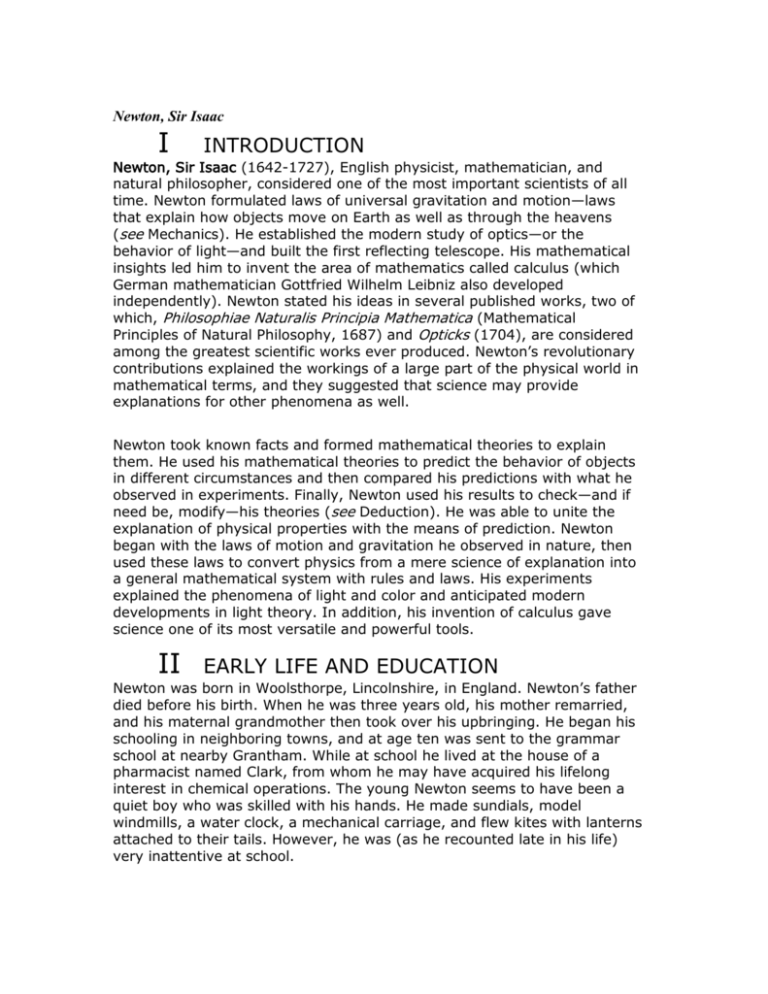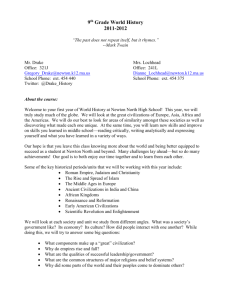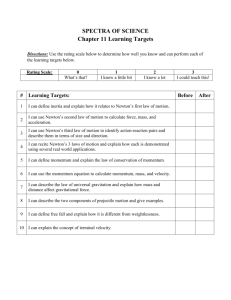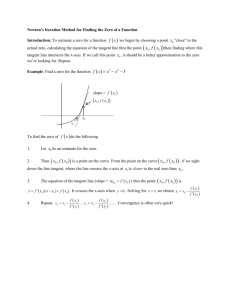
Newton, Sir Isaac
I
INTRODUCTION
Newton, Sir Isaac (1642-1727), English physicist, mathematician, and
natural philosopher, considered one of the most important scientists of all
time. Newton formulated laws of universal gravitation and motion—laws
that explain how objects move on Earth as well as through the heavens
(see Mechanics). He established the modern study of optics—or the
behavior of light—and built the first reflecting telescope. His mathematical
insights led him to invent the area of mathematics called calculus (which
German mathematician Gottfried Wilhelm Leibniz also developed
independently). Newton stated his ideas in several published works, two of
which, Philosophiae Naturalis Principia Mathematica (Mathematical
Principles of Natural Philosophy, 1687) and Opticks (1704), are considered
among the greatest scientific works ever produced. Newton’s revolutionary
contributions explained the workings of a large part of the physical world in
mathematical terms, and they suggested that science may provide
explanations for other phenomena as well.
Newton took known facts and formed mathematical theories to explain
them. He used his mathematical theories to predict the behavior of objects
in different circumstances and then compared his predictions with what he
observed in experiments. Finally, Newton used his results to check—and if
need be, modify—his theories (see Deduction). He was able to unite the
explanation of physical properties with the means of prediction. Newton
began with the laws of motion and gravitation he observed in nature, then
used these laws to convert physics from a mere science of explanation into
a general mathematical system with rules and laws. His experiments
explained the phenomena of light and color and anticipated modern
developments in light theory. In addition, his invention of calculus gave
science one of its most versatile and powerful tools.
II
EARLY LIFE AND EDUCATION
Newton was born in Woolsthorpe, Lincolnshire, in England. Newton’s father
died before his birth. When he was three years old, his mother remarried,
and his maternal grandmother then took over his upbringing. He began his
schooling in neighboring towns, and at age ten was sent to the grammar
school at nearby Grantham. While at school he lived at the house of a
pharmacist named Clark, from whom he may have acquired his lifelong
interest in chemical operations. The young Newton seems to have been a
quiet boy who was skilled with his hands. He made sundials, model
windmills, a water clock, a mechanical carriage, and flew kites with lanterns
attached to their tails. However, he was (as he recounted late in his life)
very inattentive at school.
In 1656 Newton’s mother, on the death of her second husband, returned to
Woolsthorpe and took her son out of school in the hope of making him a
farmer. Newton showed no talent for farming, however, and according to
legend he once was found under a hedge deep in study when he should
have been in the market at Grantham. Fortunately, Newton’s former
teacher at Grantham recognized the boy’s intellectual gifts and eventually
persuaded Newton’s mother to allow him to prepare for entrance to
University of Cambridge. In June 1661 Trinity College at Cambridge
admitted Newton as a subsizar (a student required to perform various
domestic services). His studies included arithmetic, geometry,
trigonometry, and, later, astronomy and optics. He probably received much
inspiration at Trinity from distinguished mathematician and theologian
Isaac Barrow, who was a professor of mathematics at the college. Barrow
recognized Newton’s genius and did all he could to cultivate it. Newton
earned his bachelor’s degree in January 1665.
III
EARLY SCIENTIFIC IDEAS
When an outbreak of bubonic plague in 1665 temporarily shut down
University of Cambridge, Newton returned to Woolsthorpe, where he
remained for nearly two years. This period was an intellectually rich one for
Newton. During this time, he did much scientific work in the subjects he
would spend his life exploring: motion, optics, and mathematics.
At this point, according to his own account, Newton had made great
progress in what he called his mathematical “method of fluxions” (which
today we call calculus). He also recorded his first thoughts on gravitation,
inspired (according to legend) by observing the fall of an apple in an
orchard. According to a report of a conversation with Newton in his old age,
he said he was trying to determine what type of force could hold the Moon
in its path around Earth. The fall of an apple led him to think that the
attractive gravitational force acting on the apple might be the same force
acting on the Moon. Newton believed that this force, although weakened by
distance, held the Moon in its orbit.
Newton devised a numerical equation to verify his ideas about gravity. The
equation is called the inverse square law of attraction, and it states that the
force of gravity (an object’s pull on another object) is related to the inverse
square of the distance between the two objects (that is, the number 1
divided by the distance between the two objects times itself). Newton
believed this law should apply to the Sun and the planets as well. He did
not pursue the problem of the falling apple at the time, because calculating
the combined attraction of the whole Earth on a small body near its surface
seemed too difficult. He reintroduced these early thoughts years later in his
more thorough work, the Principia.
Newton also began to investigate the nature of light. White light, according
to the view of his time, was uniform, or homogeneous, in content. Newton’s
first experiments with a prism called this view of white light into question.
Passing a beam of sunlight through a prism, he observed that the beam
spread out into a colored band of light, called a spectrum. While others had
undoubtedly performed similar experiments, Newton showed that the
differences in color were caused by differing degrees of a property he called
refrangibility. Refrangibility is the ability of light rays to be refracted, or
bent by a substance. For example, when a ray of violet light passes through
a refracting medium such as glass, it bends more than does a ray of red
light. Newton concluded through experimentation that sunlight is a
combination of all the colors of the spectrum and that the sunlight
separates when passed through the prism because its component colors are
of differing refrangibility. This property that Newton discovered actually
depends directly on the wavelengths of the different components of
sunlight. A refracting substance, such as a prism, will bend each
wavelength of light by a different amount.
A
The Reflecting Telescope In October 1667, soon
after his return to Cambridge, Newton was elected to a minor fellowship at
Trinity College. Six months later he received a major fellowship and shortly
thereafter was named Master of Arts. During this period he devoted much
of his time to practical work in optics. His earlier experiments with the
prism convinced him that a telescope’s resolution is limited not so much by
the difficulty of building flawless lenses as by the general refraction
differences of differently colored rays. Newton observed that lenses refract,
or bend, different colors of light by a slightly different amount. He believed
that these differences would make it impossible to bring a beam of white
light (which includes all the different colors of light) to a single focus. Thus
he turned his attention to building a reflecting telescope, or a telescope that
uses mirrors instead of lenses, as a practical solution. Mirrors reflect all
colors of light by the same amount.
Scottish mathematician James Gregory had proposed a design for a
reflecting telescope in 1663, but Newton was the first scientist to build one.
He built a reflecting telescope with a 1.3-in (3.3-cm) mirror in 1668. This
telescope magnified objects about 40 times and differed slightly from
Gregory’s in design. Three years later, the Royal Society, England’s official
association of prominent scientists and mathematicians, invited Newton to
submit his telescope for inspection. He sent one similar to his original
model, and the Society established Newton’s dominance in the field by
publishing a description of the instrument.
B
Calculus (Newton’s “Fluxional Method”)
In
1669 Newton gave his Trinity mathematics professor Isaac Barrow an
important manuscript, which is generally known by its shortened Latin title,
De Analysi. This work contained many of Newton’s conclusions about
calculus (what Newton called his “fluxional method”). Although the paper
was not immediately published, Barrow made its results known to several
of the leading mathematicians of Britain and Europe. This paper established
Newton as one of the top mathematicians of his day and as the founder of
modern calculus (along with Leibniz). Calculus addresses such concepts as
the rate of change of a certain quantity, the slope of a curve at a given
point, the computation of maximum and minimum values of functions, and
the calculation of areas bounded by curves. When Barrow retired in 1669,
he suggested to the college that Newton succeed him. Newton became the
new professor of mathematics and chose optics as the subject of his first
course of lectures.
C
Newton’s First Published Works In early 1672
Newton was elected a Fellow of the Royal Society. Shortly afterward
Newton offered to submit a paper detailing his discovery of the composite
nature of white light. Much impressed by his account, the Society published
it. This publication triggered a long series of objections to Newton’s
scientific views in general, mostly by European scientists from outside
England. Many of the criticisms later proved unsound. The strongest
criticism of Newton’s work, however, concerned his work on the theory of
gravity and came from English inventor, mathematician, and curator of the
Royal Society Robert Hooke. Hooke insisted that he had suggested
fundamental principles of the law of gravitation to Newton. Newton
answered these objections carefully and at first patiently but later with
growing irritation. These public arguments aggravated Newton’s sensitivity
to criticism, and for several years he stopped publishing his findings.
IV
THE PRINCIPIA MATHEMATICA AND LAWS
OF MOTION
By 1679 Newton had returned to the problem of planetary orbits. The idea
of a planetary attraction based on the inverse square of the distance
between the Sun and the planets (which he had assumed in his early
calculations at Woolsthorpe) ignited wide debate in the scientific
community. This law of attraction follows, in the simple case of a circular
orbit, from German astronomer Johannes Kepler’s Third Law, which relates
the time of a planet’s revolution around the Sun to the size of the planet’s
orbit (see Kepler’s Laws). The law of attraction also takes into account the
centripetal acceleration of a body moving in a circle, given by Dutch
astronomer Christiaan Huygens in 1673. The problem of determining the
orbit from the law of force had baffled everyone before Newton, who solved
it in about 1680. See also Mechanics: Newton’s Three Laws of Motion.
In August 1684 English astronomer Edmond Halley visited Cambridge to
consult with Newton on the problem of orbits. During a discussion with
Halley about the shape of an orbit under the inverse square law of
attraction, Newton suggested that it would be an ellipse. Unable to find the
calculation from which he had derived the answer, Newton promised to
send it to Halley, which he did a few months later. On a second visit Halley
received what he called “a curious treatise de motu” (de motu means “on
motion”), which at Halley’s request was registered with the Royal Society in
February 1685.
This tract on the laws of motion formed the basis of the first book of
Philosophiae Naturalis Principia Mathematica. Scientists and scholars
consider this work a milestone of scientific inquiry, and its composition in
the span of about 18 months was an intellectual feat unsurpassed at that
time. Halley played a substantial role in the development of the Principia.
He tactfully smoothed over differences between Newton and Hooke, who
insisted that Newton had stolen some of his ideas. Newton angrily decided
to suppress the third section of this work, but Halley persuaded Newton to
publish it. Halley managed Newton’s work through publication and
underwrote the cost of printing.
The Principia finally appeared in the summer of 1687. The scientific
community hailed it as a masterpiece, although Newton had intentionally
made the book difficult “to avoid being baited by little smatterers in
mathematics.” The book’s grand unifying idea of gravitation, with effects
extending throughout the solar system, captured the imagination of the
scientific community. The work used one principle to explain diverse
phenomena such as the tides, the irregularities of the Moon’s motion, and
the slight yearly variations in the onset of spring and autumn.
V
NEWTON’S LATER WORK
A few months before publication of the Principia, Newton emerged as a
defender of academic freedom. King James II, who hoped to reestablish
Roman Catholicism in England, issued a mandate to Cambridge in February
1687. This mandate called on the university to admit a certain Benedictine
monk, Alban Francis, to the degree of Master of Arts without requiring him
to take the usual oaths of allegiance to the Crown. The university saw this
mandate as a request to grant preferential treatment to a Catholic and as a
threat both to tradition and standards, so it steadfastly refused. Newton
took a prominent part in defending the university’s position. The university
senate appointed a group (including Newton) to appear before a
government commission at Westminster, and they successfully defended
the university’s rights. After the downfall of James II in the Glorious
Revolution of 1688, Newton was elected a representative of the university
in the Convention Parliament, in which he sat from January 1689 until its
dissolution a year later. While he does not appear to have taken part in
debate, Newton continued to be zealous in upholding the privileges of the
university.
Newton’s public duties brought a change to his retiring mode of life and
required frequent journeys to London, where he met several prominent
writers and intellectuals, most notably philosopher John Locke and diarist
and civil servant Samuel Pepys. In the early 1690s, possibly in response to
the intellectual exertion of writing the Principia, Newton suffered a period of
depression. Opinions differ among Newton’s biographers as to the
permanence of the effects of the attack.
In the years after his illness, Newton summoned the energy to attack the
complex problem of the Moon’s motion. This work involved a
correspondence with John Flamsteed, England’s first Astronomer Royal,
whose lunar observations Newton needed. However, misunderstandings
and quarrels marred their relationship, which ended sourly. In 1698 Newton
tried to carry his lunar work further and resumed collaboration with
Flamsteed, but difficulties arose again and Newton accused Flamsteed of
withholding his observations. The two scientists had not resolved the
dispute when Flamsteed died in 1719.
In 1696 Newton’s friends in the government secured a paying political post
for him by appointing him warden of the mint. This position required that
he live in London, where he resided until his death. Newton’s work at the
mint included a complete reform of the coinage. In order to combat
counterfeiting, he introduced the minting of coins of standard weight and
composition. He also instituted the policy of minting coins with milled
edges. Newton successfully carried out these tasks, which demanded great
technical and administrative skill, in the three years leading up to
November 1699. At that time his peers promoted him to the mastership of
the mint. This position was a well-paid post that Newton held for the rest of
his life.
In 1701 Newton resigned his chair and fellowship at Cambridge and in 1703
was elected president of the Royal Society, an office to which he was
reelected annually thereafter. In 1704, a year after the death of his rival
Hooke, he brought out his second great treatise, Opticks, which included
his theories of light and color as well as his mathematical discoveries.
Unlike the Principia, which was in Latin, Opticks was written in English, but
Newton later published a Latin translation. Most of Newton’s work on
Opticks was done long before he relocated to London. One of its most
interesting features is a series of general speculations added to the second
edition (1717) in the form of “Queries,” or questions, which bear witness to
his profound insight into physics. Many of his questions foreshadowed
modern developments in physics, engineering, and the natural sciences.
In 1705 Queen Anne knighted Newton. By this time Newton was the
dominant figure in British and European science. In the last two decades of
his life, he prepared the second and third editions of the Principia (1713,
1726) and published second and third editions of Opticks (1717, 1721) as
well.
During these last two decades Newton was entangled in a lengthy and
bitter controversy with Leibniz over which of the two scientists had invented
calculus. This controversy embittered Newton’s last years and harmed
relations between the scientific communities in Britain and on the European
continent. It also slowed the progress of mathematical science in Britain.
Most scholars agree that Newton was the first to invent calculus, although
Leibniz was the first to publish his findings. Mathematicians later adopted
Leibniz’s mathematical symbols, which have survived to the present day
with few changes.
VI
NEWTON’S IMPACT ON SCIENCE
Newton’s
place in scientific history rests on his application of mathematics to the
study of nature and his explanation of a wide range of natural phenomena
with one general principle—the law of gravitation. He used the foundations
of dynamics, or the laws of nature governing motion and its effects on
bodies, as the basis of a mechanical picture of the universe. His
achievements in the use of calculus went so far beyond previous
discoveries that scientists and scholars regard him as the chief pioneer in
this field of mathematics.
Newton’s work greatly influenced the development of physical sciences.
During the two centuries following publication of the Principia, scientists
and philosophers found many new areas in which they applied Newton’s
methods of inquiry and analysis. Much of this expansion arose as a
consequence of the Principia. Scientists did not see the need for revision of
some of Newton’s conclusions until the early 20th century. This
reassessment of Newton’s ideas about the universe led to the modern
theory of relativity and to quantum theory, which deal with the special
cases of physics involving high speeds and physics of very small
dimensions, respectively. For systems of ordinary dimensions, involving
velocities that do not approach the speed of light, the principles that
Newton formulated nearly three centuries ago are still valid.
Besides his scientific work, Newton left substantial writings on theology,
chronology, alchemy, and chemistry. In 1725 Newton moved from London
to Kensington (then a village outside London) for health reasons. He died
there on March 20, 1727. He was buried in Westminster Abbey, the first
scientist to be so honored.
Contributed By:
Richard S. Westfall
1
1"Newton, Sir Isaac."Microsoft® Encarta® Encyclopedia 2001. © 1993-2000 Microsoft
Corporation. All rights reserved.










